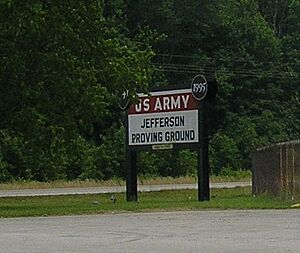Jefferson Proving Ground facts for kids
The Jefferson Proving Ground (or JPG) was a special place near Madison, Indiana. It used to be a big testing area for the United States Army. Here, the Army would test different kinds of military equipment and ammunition. Today, parts of this area are a home for wildlife. Other parts are still used for military training by the Department of Defense and private companies.
A Look Back: History
On October 8, 1940, the Army decided it needed a new place to test weapons. They needed a site where they could test many things at once. In December 1940, they chose a large area of land. This land was about 56,000-acre (230 km2) in Ripley, Jefferson, and Jennings counties in southern Indiana.
This spot was picked because it was close to other important military places. There was a powder factory in Charlestown, Indiana. There was also an ordnance plant in LaPorte County, Indiana. An ammunition storage depot was in Martin County, Indiana. Military bases like Fort Benjamin Harrison in Indianapolis, Fort Hayes in Ohio, and Forts Thomas and Knox in Kentucky were also nearby.
People living in the chosen area were asked to move within 30 to 120 days. Building work started right away. The first test shot was fired at JPG on May 10, 1941. In April 1953, JPG was very busy. It had 1,774 employees. They fired about 175,000 rounds of ammunition each month.
Some old buildings and places at JPG are very important. These include Collin's Ford Bridge and Marble Creek Bridge. Also, the Oakdale School (Building 401) and Old Timbers are listed on the National Register of Historic Places. This means they are special historical sites.
What Happened After It Closed?
In 1989, the government decided to close JPG. This was part of a plan called base realignment and closure (BRAC). JPG officially closed on September 30, 1995. Since then, the U.S. Army has kept a small team there. This team helps manage the closure and cleanup of the site.
About 50,000 acres (200 km2) of the northern part of JPG is now a wildlife refuge. Since 2000, this area has been managed by the United States Fish and Wildlife Service. It is called Big Oaks National Wildlife Refuge. It's a safe home for many animals and plants.
Another part, about 1,033-acre (4.18 km2), is still used by the military. The Indiana Air National Guard uses it for air-to-surface gunnery and bombing practice. As of 2014, this area, called Jefferson Range, is used for UAV (drone) training. This includes practicing air-to-ground attacks.
The old Railroad tracks on the site are now used to store train cars. The Madison Railroad uses them for this purpose.
Environmental Safety
The base has some depleted uranium from its testing days. The NRC has asked the Army questions about this. They want to make sure the area is safe for the environment. The Army is working to clean up the site and address these concerns.


